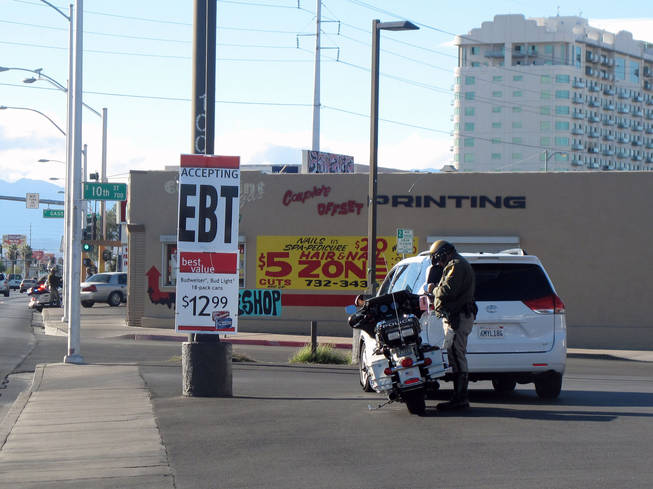
A Metro Police officer writes a ticket for a motorist who failed to stop for a pedestrian in a Charleston Boulevard crosswalk Nov. 23, 2010.
Wednesday, June 7, 2017 | 2 a.m.
Police officers are significantly less respectful and consistently ruder toward black motorists during routine traffic stops than they are toward white drivers, a paper released this week found.
The paper, published Monday in the Proceedings of the National Academy of Sciences, detailed the ways in which footage from body cameras worn by members of the Oakland Police Department in California helped illuminate the disparity in treatment.
The report was written by group of researchers in the psychology, linguistics and computer science departments at Stanford University, including Jennifer Eberhardt, a psychology professor. She said in an interview Tuesday that it was unlikely that the results were unique to Oakland and that she would expect similar imbalances to show up throughout the United States.
“Based on what we know from other research, there are police-community tensions all over the country,” she said. “You might imagine that those tensions would make their way into the language that people are using with one another.”
“We’d like to look at these issues in other agencies, but our suspicion is that there would be similar results in other places,” she added.
Racial disparities in police officers’ treatment of citizens have long been acknowledged, but the paper provided strong empirical evidence of the oft-cited phenomenon — evidence that did not rely on motorists’ memories of their interactions with the police or on the behavior of officers as observed by researchers.
Sherrilyn Ifill, the president of the NAACP Legal Defense and Educational Fund, commented on the study on Twitter: “It’s always important to have the research, but yes, we know.”
The study accounted for the race of the officer, the severity of the driver’s violation and other crucial factors. To control for the severity of the violation, for instance, the researchers ran a separate model on a subset of interactions that were rated according to the severity. The results did not change significantly, they found.
The report describes three interrelated studies that were conducted with the use of data collected from cameras worn by 245 officers during 981 stops in April 2014. In the first study, participants rated the officers’ speech for several criteria that were indicative of respect, including formality, friendliness and politeness.
In the following two studies, the researchers devised statistical models that could analyze whether the speech was respectful, finding that ratings assigned by the models were as consistent with the average human assessment as humans were with one another.
They then applied those models to more than 35,000 distinct utterances captured by the body-worn cameras, finding “strong evidence that utterances spoken to white community members are consistently more respectful.”
The paper included examples of remarks that were rated as disrespectful and respectful. “All right, my man. Do me a favor, just keep your hands on the steering wheel real quick,” was given a negative “respect score” of -0.51 partly because the driver was addressed informally and because of the directive on hand position.
Another phrase, “Sorry to stop you. My name’s Officer (name) with the Police Department,” received a score of 0.84, with the officer’s apology and introduction leading to the positive rating. The study found that white motorists were 57 percent more likely to have heard one of the most respectful statements in the data set, while black community members were 61 percent more likely to have heard one of the least respectful.
The decision to cooperate with the Stanford researchers was made by the former chief of the Oakland Police Department, Sean Whent. The department began implementing new training programs based on its findings as early as 2014. LeRonne Armstrong, a deputy chief with the Oakland police, said that the department viewed the paper as an opportunity to improve.
“I hope that people respect the fact that we are the only police department that’s willing to step out and look at these type of things,” he said. “I hope that they see promise in that a law enforcement agency is willing to take on this issue.”
Eberhardt emphasized that the findings did not necessarily indicate racial bias on the part of individual police officers. “On the whole, officers were respectful to people,” she said. “It’s just that they were more respectful to whites than they were to blacks.”
She expressed hope that the models her team developed would allow law enforcement agencies to evaluate their officers’ behavior as well as the efficacy of reforms like procedural justice, which emphasize respectful interactions with the public as central to improving trust between police officers and communities.
“It goes well beyond Oakland and well beyond race,” she said of the potential applications of her team’s methodology. “Because this is now quantified, they’d be able to measure the effectiveness of whatever interventions they try.”
